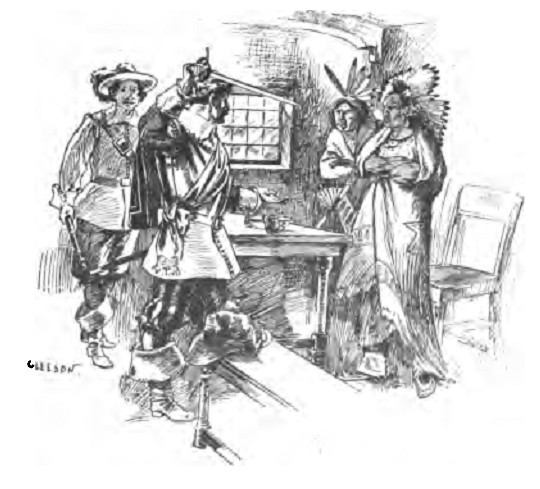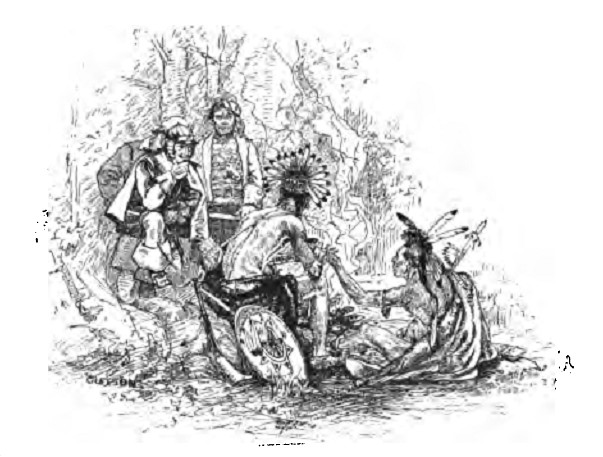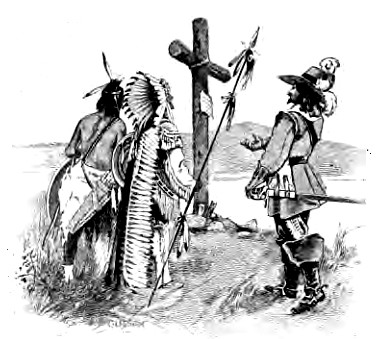| Web
and Book design,
Copyright, Kellscraft Studio 1999-2009 (Return to Web Text-ures) |
 (HOME)
|
III. HOW CAPTAIN WEYMOUTH KIDNAPPED
THE NATIVES.
CAPTAIN GEORGE WEYMOUTH, in command of the Archangel, a fine, large ship, sailed from the English Downs for America on the 31st of March, 1605. The reason given out for the expedition was the old desire to find a northwest passage to India; but it was an open secret that its real object was to keep an eye upon the French, and establish some English settlements in desirable localities. On the 11th of May Captain Weymouth came in sight of the American coast near Cape Cod. Finding himself among shoals, he sailed northwardly for a few days, and anchored on the north side of a large island, "as fair land to fall in with as could be desired," he reported. Sea fowl were plenty, and the sailors caught thirty large cod and haddock. They remained several days on the island, and "took plenty of salmon and other fishes of great bigness, good lobsters, rockfish, plaice, and lumps," and an abundance of mussels, some of which contained pearls, fourteen being taken from a single shell. Weymouth and his men also "digged a garden, sowed pease and barley and garden seeds, which, in sixteen days, grew up eight inches, although this was but the crust of the ground, and much inferior to the mold we afterwards found on the main." The adventurers were greatly delighted with the country they had found. Weymouth writes that many who had been travelers in sundry countries and had seen most famous rivers affirmed them not comparable to this, "the most beautiful, rich, large, secure harboring river that the world affordeth." When this was written they were on the St. George's River, the stream next west of Penobscot Bay. Their first relations with the Indians were very friendly, and certainly should have been satisfactory to the visitors, who relate that one Indian gave them forty skins of beaver, otter, and sable, for articles of five shillings' value. The Indians were finally induced to visit the ship, and showed great curiosity at everything they saw. Captain Weymouth, for their entertainment, and also, perhaps, in order to impress them with a sense of his extraordinary powers, magnetized the point of his sword, and with it took up needles and knives. The Indians regarded this as magic, but the process of writing seemed to them even more marvelous. They watched with amazement, and even with fear, the writing down of the names of the articles bought and sold.  Two of the Indians lunched on board the ship, and found the pewter dishes magnificent. They asked to be allowed to carry some green pease—to them a new and delicious dainty—home to their squaws. When the white men returned the visit, the Indians built a great camp fire, the highest mark of hospitality, and gathered around it in solemn silence. They carefully covered the seats around the fire with deerskin cushions, and then offered pipes and tobacco—such good cheer as they had—to their guests. They displayed their bows and arrows, perhaps with some such private motives as may have moved Captain Weymouth to show them his necromancy. The bows were made of the toughest wood of the forest, the art of selecting and preparing it being handed down from one generation to another. It needed tough muscles, too, and trained ones, to use the bows, but from the right hands an arrow could be sped with fearful force. The javelins were made of wood, and their manufacture was a matter of great skill and of especial pride. They were barbed with bone, and the barbs were often poisoned. Although of small avail against the firearms of civilization, these Indian weapons were capable of terrible execution upon a surprised or unarmed foe. Lurking in ambush, the savages hurled them to a great distance, and with an accuracy of aim that seemed almost miraculous. When they obtained muskets and guns of the white men, the skill in aiming which they had acquired with their arrows made them formidable foes. On a certain night when the Indians entertained the Archangel's company around their camp fire, Owen Griffin, one of the men, was left on shore as a watchman. This may have been done because Weymouth really suspected treachery on the part of the savages, but the fact that three of the Indians were taken on board the ship as hostages for Griffin makes it seem probable that Weymouth was merely maturing his plans for kidnapping some Indians. He openly acknowledges that this was his intention from the beginning, and even justifies the deed, as do, astonishingly, some historians of a later and more enlightened time, on the ground of its great benefit to humanity. That the end justifies the means is apt to be very dangerous doctrine, as it is certainly a very hard one to accept in the case of the poor Indians, torn from home and kindred by worse than savage treachery. While on the coast, Weymouth treated with great kindness all the natives he encountered. Those whom he captured, after recovering from their surprise and alarm, and perceiving by their kind usage that no harm was intended them, became contented and tractable, and very willing to impart the information desired of them. To return to the story of the kidnaping: Owen Griffin remained on shore, and the three Indian hostages slept on the orlop deck of the Archangel, with a pile of old sails for a bed. They showed great fear of the English dogs, and the dogs, on their part, always manifested a want of sympathy with Indians. The next day was Sunday; and when the Indian canoes set out for the ship with articles for barter, Captain Weymouth waved a signal for them to go back. There being no Sundays in the savage calendar, this was a mystery which they, doubtless, thought might savor of the treachery of which they were constantly suspicious. But they returned, and did not venture a second time toward the ship that day. The next morning the canoes appeared again, and the occupants made signs to indicate that the chief of their tribe was waiting a little farther up the bay with fine Pars to barter. Captain Weymouth set out in a boat with eight men to find the chief; but, as always, he suspected treachery, which is, perhaps, not strange, when one considers what his own designs were. So he sent Owen Griffin on shore in the canoe in which the invitation had been brought, retaining as hostage one of the three Indians who had paddled it. The Indians gave a very full and candid description of their chief's situation and surroundings. He had two hundred and eighty followers with him, armed, as usual, with bows and arrows. He had also a great pack of Indian dogs and tamed wolves. When Owen Griffin reached the place, there were no furs at all for traffic. The Indians urged him to go farther up the stream, to the place where they said their furs were stored. It seems unlikely that they had any treacherous designs, for if they had they could have accomplished them as well where they were as farther up the river; and Captain Weymouth held an Indian as hostage in his boat. But Owen Griffin had not been chosen for his bravery. He was afraid, and he returned to Captain Weymouth with a report which made the captain think it unsafe to land. The natives, on their part, felt increased suspicions that the white visitors meant them harm. When two canoes, with three Indians in each, paddled near to the ship, Captain Weymouth tried in vain to lure them on board. When he extended a dish of green pease, they seized them, but paddled away to a distance and devoured them. After that two in the other canoe ventured to go on board. When one of the pea-eaters, a fine, athletic young brave, politely returned with the dish, Captain Weymouth beguiled him on board, and induced him to go to the cabin below, where the two other Indians were being entertained. There the three poor savages soon found that their suspicions of treachery were realized, for the cabin door was locked against them. These three being secured, the enterprising Captain , Weymouth straightway set to work to kidnap some more. There had been six Indians in the canoes, and three of them were now on shore. He sent out a boat, manned by eight of the strongest sailors, to pretend that they wished to buy furs. They carried another can of pease. The savages' vulnerable point seems to have been an appetite for pease.  One of the Indians took to the woods and escaped, but the other two were persuaded to sit down before their fire with the white visitors; and they all ate together like brothers until suddenly, watching their opportunity, the stout sailors sprang upon their victims and, after a terrible struggle, dragged them to their boat and finally on board the ship. "Thus," triumphantly writes Rosier, who kept the journal of the voyage, " we shipped five savages and two canoes, with all their bows and arrows." One of these young Indians was a chief, and two others were of rank in their tribe. They had come from their home at Pemaquid to visit the white strangers, of whom they had heard. The names of four of these captives were Tisquantum, Nahanada, Skitwarroes, and Assacomet, one being a sagamore, or head chief. The first three Weymouth delivered to Sir Ferdinando Gorges, who was at that time the governor of Plymouth, England; the other two were probably assigned to Sir John Popham, an English judge who was much interested in American affairs. Sir Ferdinando Gorges, who has been called the father of English colonization in New England, kept the three Indians in his family for several years. He treated them with great kindness, and had them taught the English language; and he so well improved the opportunity given him to acquire a knowledge of the region visited by Weymouth that he says: " The capture of these Indians must be acknowledged the means, under God, of putting on foot and giving life to all our plantations." It was intended that the Indians should be returned to their homer, and when the Plymouth Company was formed, two of them, Nahanada and Assacomet, were placed on board a ship which sailed from Bristol, England, for the coast of Maine. The ship encountered a Spanish fleet, and was captured—England being then at war with Spain—and carried off, a prize, to Spain, which country had already learned to make slaves of the Indians, as many as could be caught. So the second captivity of these two poor Indians was far worse than their first. But there were then many Spanish vessels sailing to the American shores for fishing or trading, and in some one of these Nahanada was so fortunate as to find his way back to his native land. It was Nahanada that was supposed to be a chief of high rank. When, in 1607, the Plymouth Company attempted to plant a colony at the mouth of the Sagadahoc River, in Maine, Skitwarroes, another of the kidnapped Indians, was sent over on board a vessel called the Mary and John. The ship came to anchor near Pemaquid, and the captain, manning a boat, took Skitwarroes as a guide, and rowed across the bay to the mainland. Skitwarroes led the way to a little Indian town in what is now Bristol. But the Indians had learned from Weymouth's kidnaping to regard the English as fiends. The air was filled with the shrieks of squaws and children, and the men prepared for a vigorous defense. Skitwarroes tried to reassure them, but in his English dress they failed to recognize him. But when Nahanada caught sight of his fellow-prisoner, he rushed into his arms, and the terrified Indians were soon calmed by the influence of their two chiefs. We hear, later in the history of the colonies, of these three Indians, Nahanada, Skitwarroes, and Assacomet, who had made so strange and painful a journey into the great world of the white man; and they seem to have acted the part of peacemakers between their people and the Europeans. Tisquantum, also, or Squantum, as he is called by later historians, was returned to his native country, and was the first Indian who visited the Pilgrims of the Plymouth colony. He had forgotten or forgiven the treachery of the English, and was the firm friend of the Pilgrims, acting as interpreter between them and the savages, and doing much to preserve peace and friendly relations. But let us return to the Archangel, with her imprisoned Indians. Weymouth was preparing to set sail, having no desire to linger until the fate of five of their number should become known to the Indians, when two large canoes were discovered, making for the ship. They were highly decorated canoes, and the Indians in them were elaborately painted and gorgeously dressed in their barbaric fashion. It was evidently an embassy of great importance, for it bore all the marks of that display and ceremony which the wild, forest-reared Indians loved so well. One of them even wore a coronet in which glass beads, the feathers of wild fowl, and real pearls were somewhat queerly but not ineffectively mingled. And this was not merely an ornament with which any one who chose might adorn himself, but showed that the wearer was of royal blood. They came with an invitation to Captain Weymouth to visit, in his ship, their great lord, the head chief of the Pemaquid tribes. They came on board the Archangel, and were entertained upon the deck, quite unconscious of their miserable captive brothers below. That Captain Weymouth did not seize them and carry them away captive was probably due only to his lack of accommodation for any more prisoners than he had. He declined the invitation, but dismissed them with much politeness and many assurances of friendly esteem. He set sail immediately after the departure of the embassy, and sailed westerly along the Maine coast, of which he has left an enthusiastic description. While the Archangel lay at anchor in the Sagadahoc, an Indian canoe appeared, that had followed on her track as soon as the kidnaping of the Indians was discovered. It was rowed by many Indians, and in it was the Indian prince, who had come to try to rescue his countrymen. His supplications were, of course, all in vain. Weymouth invited him to the religious ceremony of planting a cross at the mouth of the Androscoggin River, where he said to him: " It is in the name of Jesus Christ that I have kidnapped your friends. It is Christianity which authorizes these deeds. Some of my countrymen will soon appear to teach you to embrace this religion."  On the homeward voyage of the Archangel a discovery was made which has proved a great blessing to the world. When about a hundred miles from land, the ship ran into shoal water, the depth dwindling gradually to less than twenty-five fathoms. In this shoal water the Archangel was one day wholly becalmed, and a sailor, Thomas King, whose name should be held in remembrance as that of a great discoverer, was moved by what old Izaak Walton calls "the primal, honest instinct of humanity to fish." He cast out a line, and drew up a codfish of quite astonishing size. Other sailors followed his example, and fine fat codfish were caught almost as fast as the fishermen's arms could move. For then, as now, the Grand Banks of Newfoundland swarmed with fish. |